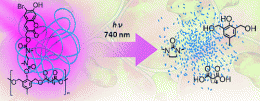New 'smart' material could help tap medical potential of tissue-penetrating light

Scientists are reporting development and successful initial testing of the first practical "smart" material that may supply the missing link in efforts to use in medicine a form of light that can penetrate four inches into the human body. Their report on the new polymer or plastic-like material, which has potential for use in diagnosing diseases and engineer new human tissues in the lab, appears in ACS' journal Macromolecules.
Adah Almutairi and colleagues explain that near-infrared (NIR) light (which is just beyond what humans can see) penetrates through the skin and almost four inches into the body, with great potential for diagnosing and treating diseases. Low-power NIR does not damage body tissues as it passes. Missing, however, are materials that respond effectively to low-power NIR. Plastics that disintegrate when hit with NIR, for instance, could be filled with anti-cancer medicine, injected into tumors, and release the medicine when hit with NIR. Current NIR-responsive smart materials require high-power NIR light, which could damage cells and tissues. That's why Almutairi's team began research on development of a new smart polymer that responds to low-power NIR light.
Hit with low-power NIR, their new material breaks apart into small pieces that seem to be nontoxic to surrounding tissue. The researchers envision, for instance, putting the polymer in an implantable "hydrogel," which is a water-containing flexible material used for tissue engineering and drug delivery. A hydrogel with the new polymer could release medications or imaging agents when hit with NIR. "To the best of our knowledge, this is the first example of a polymeric material capable of disassembly into small molecules in response to harmless levels of irradiation," say the researchers.
More information: Low Power, Biologically Benign NIR Light Triggers Polymer Disassembly, Macromolecules, 2011, 44 (21), pp 8590–8597. DOI: 10.1021/ma201850q
Abstract
Near infrared (NIR) irradiation can penetrate up to 10 cm deep into tissues and be remotely applied with high spatial and temporal precision. Despite its potential for various medical and biological applications, there is a dearth of biomaterials that are responsive at this wavelength region. Herein we report a polymeric material that is able to disassemble in response to biologically benign levels of NIR irradiation upon two-photon absorption. The design relies on the photolysis of the multiple pendant 4-bromo7-hydroxycoumarin protecting groups to trigger a cascade of cyclization and rearrangement reactions leading to the degradation of the polymer backbone. The new material undergoes a 50% Mw loss after 25 s of ultraviolet (UV) irradiation by single photon absorption and 21 min of NIR irradiation via two-photon absorption. Most importantly, even NIR irradiation at a biologically benign laser power is sufficient to cause significant polymer disassembly. Furthermore, this material is well tolerated by cells both before and after degradation. These results demonstrate for the first time a NIR sensitive material with potential to be used for in vivo applications.
Provided by American Chemical Society

















